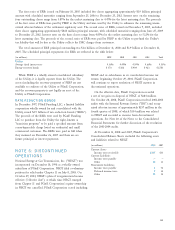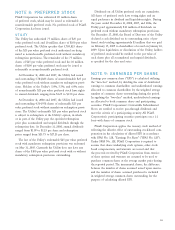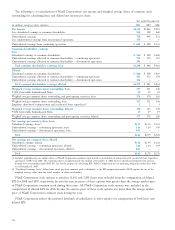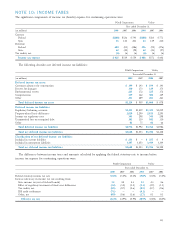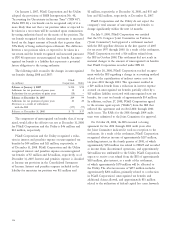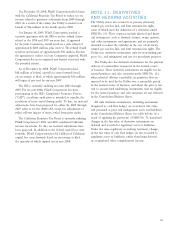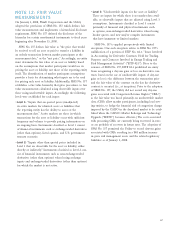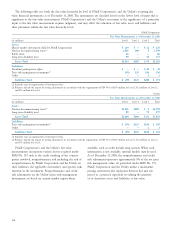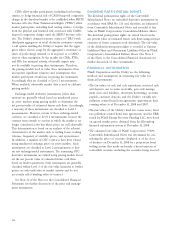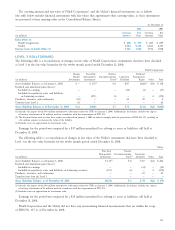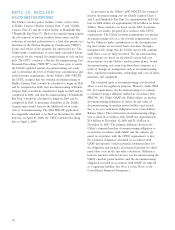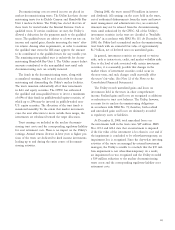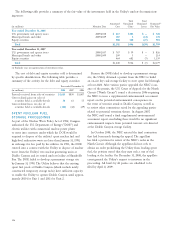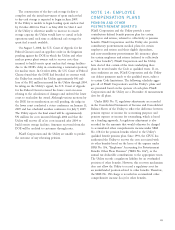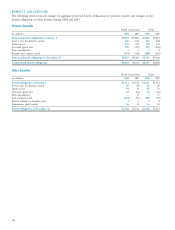PG&E 2008 Annual Report Download - page 119
Download and view the complete annual report
Please find page 119 of the 2008 PG&E annual report below. You can navigate through the pages in the report by either clicking on the pages listed below, or by using the keyword search tool below to find specific information within the annual report.117
• Level 3: “Unobservable inputs for the asset or liability.”
These are inputs for which there is no market data avail-
able, or observable inputs that are adjusted using Level 3
assumptions. Instruments classifi ed as Level 3 consist
primarily of fi nancial and physical instruments such
as options, non-exchange-traded derivatives valued using
broker quotes, and new and/or complex instruments
that have immature or limited markets.
SFAS No. 157 is applied prospectively with limited
exceptions. One such exception relates to SFAS No. 157’s
nullifi cation of a portion of EITF No. 02-3, “Issues Involved
in Accounting for Derivative Contracts Held for Trading
Purposes and Contracts Involved in Energy Trading and
Risk Management Activities” (“EITF 02-3”). Prior to the
issuance of SFAS No. 157, EITF 02-3 prohibited an entity
from recognizing a day-one gain or loss on derivative con-
tracts based on the use of unobservable inputs. A day-one
gain or loss is the difference between the transaction price
and the fair value of the contract on the day the derivative
contract is executed (i.e., at inception). Prior to the adoption
of SFAS No. 157, the Utility did not record any day-one
gains associated with Congestion Revenue Rights (“CRRs”)
as the fair value was based primarily on unobservable market
data. (CRRs allow market participants, including load serv-
ing entities, to hedge the fi nancial risk of congestion charges
imposed by the CAISO in the day-ahead market to be estab-
lished when the CAISO’s Market Redesign and Technology
Upgrade (“MRTU”) becomes effective.) The costs associated
with procuring CRRs are currently being recovered in rates
or are probable of recovery in future rates. The adoption of
SFAS No. 157 permitted the Utility to record day-one gains
associated with CRRs resulting in a $48 million increase
in price risk management assets and the related regulatory
liabilities as of January 1, 2008.
NOTE 12: FAIR VALUE
MEASUREMENTS
On January 1, 2008, PG&E Corporation and the Utility
adopted the provisions of SFAS No. 157, which defi nes fair
value measurements and implements a hierarchical disclosure
requirement. SFAS No. 157 deferred the disclosure of the
hierarchy for certain non-fi nancial instruments to fi scal years
beginning after November 15, 2008.
SFAS No. 157 defi nes fair value as “the price that would
be received to sell an asset or paid to transfer a liability in
an orderly transaction between market participants at the
measurement date,” or the “exit price.” Accordingly, an entity
must determine the fair value of an asset or liability based
on the assumptions that market participants would use in
pricing the asset or liability, not those of the reporting entity
itself. The identifi cation of market participant assumptions
provides a basis for determining what inputs are to be used
for pricing each asset or liability. Additionally, SFAS No. 157
establishes a fair value hierarchy that gives precedence to fair
value measurements calculated using observable inputs over
those using unobservable inputs. Accordingly, the following
levels were established for each input:
• Level 1: “Inputs that are quoted prices (unadjusted)
in active markets for identical assets or liabilities that
the reporting entity has the ability to access at the
measurement date.” Active markets are those in which
transactions for the asset or liability occur with suffi cient
frequency and volume to provide pricing information on
an ongoing basis. Instruments classifi ed as Level 1 consist
of fi nancial instruments such as exchange-traded derivatives
(other than options), listed equities, and U.S. government
treasury securities.
• Level 2: “Inputs other than quoted prices included in
Level 1 that are observable for the asset or liability, either
directly or indirectly.” Instruments classifi ed as Level 2 con-
sist of fi nancial instruments such as non-exchange-traded
derivatives (other than options) valued using exchange
inputs and exchange-traded derivatives (other than options)
for which the market is not active.




